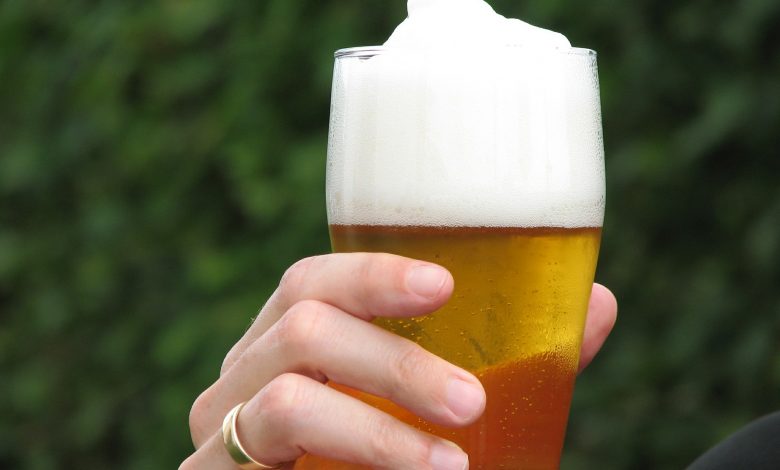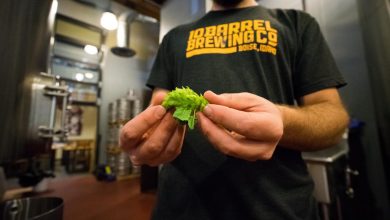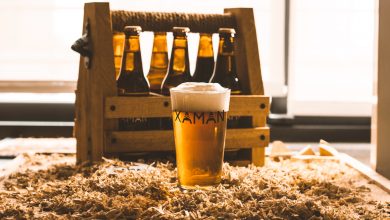Hefeweizen: The Rising of Craft Beer

Session lagers are extremely popular at the present time. Magnificent stouts and twofold IPAs have a place, no doubt, yet microbrew customers are progressively requesting more flavors from less liquor. Accordingly, homebrewers and business brewers are thinking up some superb new styles.
Among the emerging craft beers, Hefeweizen is becoming the favorite in the town. Hefeweizen is the first wheat brew, and it is among the numerous styles of lager accessible in the market. It was initially crafted in Germany and is a fresh, drinkable lager that is most loved throughout the mid-year months. You can without much of a stretch remember it as the frosty, pale beer that leaves a ton of yeast in a vacant glass.
What is Hefeweizen?
Hefeweizen (articulated as hay-fuh-veyt-ssenn and not haffie-vi-zon) is the more famous word amongst Americans for what Germans name as weissbier or Weizenbier. The style of Hefeweizen originates before ales and pale beers. Weissbier, which signifies “white lager,” was at first used to portray wheat lagers since they were lighter in color compared to the common lagers fermented in Germany.
Hefe deciphers as “yeast,” and Weizen implies as “wheat.” Yeast in the title alludes to the way that this unfiltered lager stays frosty due to the dissolved yeast. The yeast likewise contributes one of a kind characteristics to the fragrance and taste of a hefeweizen.
Wheat brews were amongst those illegal beers under the German virtue law called Reinheitsgebot. Set up in 1516, it basically just permitted the creation of brews without any aides or non-grain food. Because of the fame of weissbier among royals, it was the principal style to get an exception.

History of Hefeweizen
People have remembered wheat for lager for a great length of time that has been fermenting. Indeed, its fame as a blending grain was among the components that provoked the first Reinheitsgebot announcement of 1516. 16th century Europe encountered what history specialists have proclaimed a price revolution, a time of expansion that saw costs increment in all cases. Keeping wheat along with rye out of the brewhouses guaranteed that there was sufficient to go around for preparing bread, a healthfully prevalent, more vitality-dense item.
Be that as it may, there was a significant exemption. The House of Denenberg within Schwarzach — around 80 miles or 129 km upper east of Munich — held an illustrious benefit to blending wheat lager, despite the fact that it actually disregarded the Reinheitsgebot. In return for installments to Duke Wilhelm IV (co-creator of the 1516 declaration), the Degenbergers were permitted to keep preparing wheat brew, hence, guaranteeing their devotion to the Bavarian duchy.
In the year 1602, the Degenberg line finished without a successor, and the wheat brew benefit moved to Maximilian I, the grandson of Wilhelm. In this manner, there started a state imposing business model on wheat lager preparing that made the House of Wittelsbach get a lot of cash for the following 270 years. Just in 1872 did the Wittelsbachs offer their illustrious benefit to Georg Schneider, whose brew making in Kelheim proceeds with today as G. Schneider and Sohn, makers of the exceptionally respected Schneider Weisse and Aventinus Weizenbock.
Hefeweizen Profile
Hefeweizen is a joy for the senses. Lawfully, true Bavarian models must be fermented with about 50 percent of the wheat malt; however, 60 to 70 percent is progressively normal. The huge part of wheat in the grain adds a bready taste with a delicate, pillowy aftertaste and a medium-full body. The sourness of the hop is sufficient to balance the malt sweetness, and there are, for all intents and purposes, no hop taste or fragrances.
The yeast truly makes this style unique. Bavarian weissbier strains make incredible astors and phenolics that convey the impression of banana, bubblegum, and clove attributes. The brew is given out unfiltered with a lot of yeast (however, German models are often packaged with an ale strain). What’s more, articulated foam comprises more than three volumes or six g/L of carbon dioxide, combined with the high protein content of the wheat, which makes a thick, cushy head that appears charming when the brew is immersed in its unique, vase-like glass.

Serving and Drinking Hefeweizen
Wheat lagers are best presented in a particular style of glassware, known as a Weizenbier glass. It would seem like a shifted tulip with a small base that opens up to a more extensive center and afterward somewhat tapers a little again at the edge. The shape assists the structure to be the ideal whitehead once the brew gets served.
To serve Hefeweizen, hold the glass at an edge and gradually pour the brew till the head arrives at the edge. Wait for a while for the froth to set, and at that point, twirl the brew, staying in the jug, to excite the yeast and keep serving.
Hefeweizen tastes the best when it is cold and in a glass that has been washed in cool water.
It has become an American custom to present Hefeweizen with a lemon wedge. Conventionalists and Bavarians disapprove of this activity. They think the citrus brings down the genuine taste of the brew and forestalls the production of an ideal froth head.
The Taste of the Hefeweizen
Hefeweizen is a brilliant gateway to brew lager since it is both simple on the sense of taste and considerably unique in relation to the pale, slender brews that rule the market. Because of their unfiltered creation, Hefeweizens serve frost with a flawless orange-yellow sparkle and produce an excellent, dense, aromatic head. Consumers ought to expect a creamy aftertaste joined by a charming fizz coming about because of a genuinely high level of carbonation.
Taste and fragrance of citrus, banana, and clove are predominant, with the flavor of green apple along with bubblegum in the interest of admiration. It’s additionally not bizarre to experience components of pepper and herbs. Low degrees of sourness and a lot of brilliant notes settle on hefeweizen, and therefore, it is a decent decision for the individuals who favor their brew on the reviving side. More profound flavors in addition will creep in as liquor content ascents, and a few consumers may taste the stone fruit, malt, bread, and vanilla.

What Makes Hefeweizen Different From Other Wheat Beers?
Wheat lager is essentially a sort of lager which is blended with a huge amount of wheat. It comprises a huge amount of wheat malt that ranges from half to 70 percent, while the remaining is simply customary grain malt. There are various sorts of wheat brew throughout the world – for example, the German Weissbier and Belgian wheat lager.
The German Weissbier can be additionally partitioned into four classifications on the extent of wheat, hops, and yeast utilized, specifically Kristallweizen, Dunkelweizen, Weizenbock and Hefeweizen. Kristallweizen signifies ‘clear wheat’ since it is intensely sifted, bringing about an exceptionally clear brew. Dunkelweizen is fermented with darker malts and finishes in a darker, bready brew.
Weizenbock is a basic style of German ale that is generally malty, to some degree sweet, firmly alcoholic, and with almost no hop flavor or fragrance. It consolidates the qualities of the two styles. Hence, it is the most authentic of the wheat lagers.
Hefeweizen is the most mainstream of all the Weissbier kin. This is an unstrained lager, which means the maker’s yeast is moved in suspension, making the brew frosty and somewhat white looking. The dense wheat profile provides them an exceptionally invigorating taste. As you inhale the aroma of your Hefeweizen, you will see a blend of fruity and fiery fragrance.

Difference Between German Hefeweizen and American Hefeweizen
Hefeweizen originated in Germany; however, the style rose to fame in America because of German settlers. Shockingly, a portion of the characteristics that make a Hefeweizen a genuine German wheat brew has been forgotten in American translation. The two have a huge contrast in taste on account of the kind of yeast each utilizes. American brewers utilize American yeast strains, and that makes their lagers maltier compared to that of Germans.
Some more different contrasts between the two are the utilization of hops and malt. German brewers scarcely utilize hops in the Hefeweizens to abstain from adding sourness or dryness to the smooth equalization of astors, phenolics, and the matured wheat season. German hefe likewise has a more prominent measure of wheat compared to the American sorts of Hefeweizens.
Quick Facts about Hefeweizen
- Category: Vollbier
- Sort of Beer: Ale
- Concentrate Value: 11 to 14 percent
- IBU: 8 to 15
- Where to Find: Essentially in Bavaria (Bayern), yet developing in prominence all through Germany
- Famous Brands: Paulaner, Erdinger
- Lager Characteristics: It’s marginally hazy; pale in color. The flavor is regularly portrayed as fruity (like a banana) or as bitter and spiced. It has an extremely gentle hops flavor. A glass Weizenbier consistently has a tall, white, rich froth (head) on top.
- Alcohol by Content: A hefeweizen is normally quite low as far as liquor by content. By and large, a hefeweizen will fall in the vicinity about 5% to 7%. This is one reason that many individuals appreciate Hefeweizen so much: the pale color and energetic smell and flavor make it simple to appreciate without it feeling substantial or hitting you immediately as you take your first sip.
- Serving Suggestions: For ideal taste, present chilled Hefeweizen at about 46 – 50 degrees F or 8 – 10 degrees C and in a customary tall, slim glass. The stature of the glass provides the carbonation in the brew far to go to the top, keeping the lager crisp and spritz. A Weizenbier is presented with a wedge of lemon. Nonetheless, this is definitely not a Bavarian convention. It is accepted that the juice from the lemon wedge obliterates the rich froth – a significant piece of the Weizenbier!

How to Homebrew a Hefeweizen
Building up the recipe of Hefeweizen is so easy and simple, and it is an exquisite novice style. Focus on a unique gravity about 1.050 or 12.3 degrees P, or a few ticks on either side, utilizing a grist of somewhere in the range of 50 to 70 percent of malted wheat. The rest of it will be Pilsner malt, or utilize light Munich malt for some additional bready taste. A few acidulated malts might be called for to obtain the pounded pH within the sweet spot. Essence brewers can essentially utilize dried or liquid wheat malt essence, which is normally 65 percent of wheat and 35 percent of pale malt. Soaking a little of dextrin malt can include a crisp malt texture.
Tettnang hops are connected with this lager style, yet any rich assortment will do the task. You just need a souring charge to the tuning of 12 IBU or somewhere in the vicinity, and in all honesty, you can accomplish that with pretty much any hop you happen to have close by. Avoid hops that convey a severe sourness, though, because we are after a delicate, welcoming kind of sourness in the beer.
The pounding can be as straightforward as a solitary mixture at 150 degrees F or 66 degrees C, yet a conventional decoction pounding with rests in the middle to upper 140s degrees F or mid 60s degrees C and the upper 150s to lower 160s degrees F or low 70s degrees C can advance a progressively attenuative wort with improved malt character. A discretionary pounding rest at 110 degrees F or 43 degrees C advances the improvement of ferulic corrosive, which Hefeweizen yeast afterward changes to four vinyl guaiacol, the mixture required for the style’s clove essence. When you’ve gathered your wort, boiling for an hour with a solitary hop expansion toward the start is required.
Maturation temperature is genuinely forgiving, and extraordinary Hefeweizen can be brewed pretty much anywhere in the range of 60 to 66 degrees F or 16 to 19 degrees C; however, it requires generally cool maturing about 62 to 64 degrees F or 17 to 18 degrees C will, in general, produce the best outcomes. This is a brewing style that advantages extraordinarily from open maturation, so whether your sanitation is acceptable, consider covering your container or carboy with free sterilized foil. In case you’re uncertain, simply utilize your typical sealed maturation convention, yet leave a lot of headspaces and utilize the blowoff tube. Hefeweizen yeast is totally aggressive!
At the point when maturation is finished, package and make the most of your Hefeweizen as quickly as time permits. It is intended to drink it young, and it is altogether likely to go from grain to glass in about fourteen days in the event that you keg your brew. Focus on making 3 to 3.5 volumes or 6 to 7 g/L of carbon dioxide; however, be careful — this degree of carbonation may cause various “ordinary” brew containers to blast. In the event that you bottle, utilize a denser glass that can deal with the raised weight, or opt for plastic PET jugs to be absolutely protected.

Food Pairings with Hefeweizen
When the official beginning of summer is as yet a month away, and when the summery climate has just started to show up, it’s an ideal opportunity to break out the Hefeweizen.
People love Hefeweizen because of its sharp taste of the banana, clove, or fermented yeast. However, the peculiar characteristics of Hefeweizen are what make it fantastically food-friendly and ideal for easier summer fare.
A display of foods that pair pleasantly with Hefeweizen, a German-style wheat lager with bunches of air bubbles and a somewhat sweet and fruity flavor.
- Watermelon and Tomato Salad: Serving a rendition of this invigorating dish during the pre-fall with a chilled glass of Hefeweizen is a blissful delight.
- Lobster and Avocado Salad: The smooth and creamy components in this plate of mixed ingredients coordinate Hefeweizen’s smoothness, whilst the vinegar and citrus support the brew’s flavor of natural products.
- Mashed Beets with Goat Cheese: Hefeweizen consistently matches well with goat cheese, and the spices and herbs in this serving of salad further upgrade fiery notes in the brew.
- Ricotta Crostini with Black Olives, Lemon Zest, and Mint: Enchantment happens when this tangy and luscious hors d’oeuvre meets the cold, air bubbly dark Hefeweizen.
- Crab Salad with Celeries: This crispy, splendid serving of salad, which does not contain mayo, has a place with a light-bodied Hefeweizen with some traces of sweetness.
- Lemon Risotto: Enhance the dish’s deep lemon flavors with a Hefeweizen presented with a lemon slice.
- Speared Shrimp on Rosemary: The solid presence of rosemary pervading briny, delicious shrimp will hit the massive flavors with a herb-driven Hefeweizen.
- Cedar-Smoked Salmon: You needn’t bother with a smoker to loan a somewhat hot, faintly sweetish trace of the outdoors to crisp salmon. The zing enhances when this luscious dish is paired with Hefeweizen.
- Banana Pudding: For an excellent matching, search for a costly German Hefeweizen, which carries notes of clove and banana to this rich, exemplary sweet dish.
Health Benefits of Hefeweizen
As a matter of fact, the importance is definitely given to beer when it comes to perceiving their advantages. Hefeweizen in particular decreases muscle irritation and helps in increasing respiratory wellbeing. Different advantages of brew, by and large, may incorporate Skeletal strengthening, staying mentally sharp, reducing the dangers of kidney stones, calming inflamed muscles, and impacts of vitamin E, which provide a shine to the skin and cause the drinker to feel happier.
Furthermore, it is stated that some ingredients utilized in making the brew which give it a severe taste and go about as an additive are in high quantity in a plant-estrogen. However, with Hefeweizen, you don’t need to worry about that.

Pouring Tips to Serve a Hefeweizen
Because of the suspended yeast that provides this style a frosty look, there is a particular method to pour Hefeweizen so as to give an ideal head of froth. Here is the simple bit by bit procedure to guarantee that you take full advantage of your crafted hefeweizen.
- Utilize the correct glass: For Hefeweizen, utilize a glass that is narrow at the bottom but with a wide opening at the top. The glass should be made to guarantee that there is a decent measure of space for froth at the top of the beer.
- Wash using cold water first: Washing the glass using cold water will guarantee that the brew does not pour with a lot of carbonation. No one prefers a brew that is for the most part frothy!
- Make the angle of the glass: Hold your glass at a 45-degree angle and enable the brew to run down its one side. This will assist in taking out the characteristical propensity of a Hefeweizen to be vigorously carbonated.
- Leave about an inch of lager at the base of the glass: When there is about an inch or more of brew left, twirl the bottle to accumulate the yeast residue and afterward empty the rest of it into the lager. This adds to the ideal frothiness of the Hefeweizen and enhances the flavors. Yeast is likewise brimming with nutrients, so there is an additional health advantage too!
There you have the perfect glass of Hefeweizen with the ideal Hefeweizen pour! No matter if you need refreshment on a hot day or would love to have a feast with your friends and family, Hefeweizen has got you covered.



